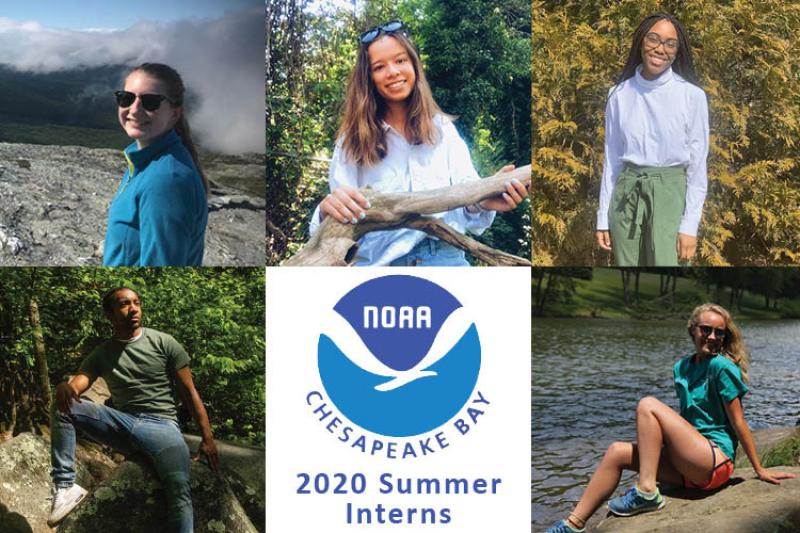NOAA Chesapeake Bay Office 2020 summer interns (clockwise from lower left): Kerry Mason, Hadley Menk, Shalom Fadullon, Brooke Goggins, Isabel Whaling.
The NOAA Chesapeake Bay Office, in partnership with the Chesapeake Research Consortium, is hosting five interns this summer. They started in mid-June and are with us until mid-August. Usually, our summer interns work in person with NOAA staff at our offices and in the field. This year is, of course, different. The interns are teleworking and are meeting frequently with their mentors and other staff virtually. With us this year:
-
Kerry Mason just graduated from Virginia Commonwealth University with a major in environmental studies. For his internship, he is doing data analysis about the oyster population in the Chesapeake Bay by conducting statistical tests and creating graphs in RStudio.
-
Hadley Menk is a rising senior at the University of St. Andrews (in Scotland); she is a double major in geography and modern history. She is working with our Education Team to create an interactive, GIS-based map. It will show where our Bay-Watershed Education and Training grant projects are located, which grade levels were funded, and what the funded projects achieved.
-
Shalom Fadullon is a rising junior at the University of Delaware. Shalom is a double major in chemical engineering and environmental and energy policy. This summer, she is working to develop a Chesapeake Bay water temperature indicator for critical fish habitat areas in the Bay. This work will help determine future practices to increase resiliency.
-
Brooke Goggins is a rising sophomore at Penn State University, where she is majoring in biological engineering with a minor in political science. For her internship, Brooke is working on a suite of indicators to track the health of forage species in the Chesapeake Bay.
-
Isabel Whaling is a rising senior at the University of South Carolina, majoring in marine science with an emphasis in geological oceanography. She is creating visualizations of data from the Chesapeake Bay Interpretive Buoy System. They will be used for educational purposes and to help interpret how climate change is affecting the Chesapeake.
Describe a time when you were surprised by fish and/or habitat.
-
Brooke distinctly recalls the first time her father took her fishing—-the first thing they caught was a water bottle. She notes that the event really shed some light on the health of the environment around her.
-
Hadley was walking down a creek right down the street from her home near Burlington, Vermont, and she saw a beaver swimming and eating vegetation from the riverbank. She walks or runs by that spot nearly every day when she’s home, and had never seen one there or had any idea they lived in the area.
-
Isabel had a similar experience running along the Congaree River in Columbia, South Carolina, while out on a run. Signs say to watch for alligators, but she had never seen one there. One day, there was an alligator on the bank enjoying the sun. Isabel notes she started running very quickly in the opposite direction!
-
Shalom was out on a dock (her home is Annapolis, Maryland) when she saw two fins in the water. Her first thought was that it was a shark, but knew it was more likely to be dolphins. The area was pretty shallow, too. She later found out it was the “wingtips” of a cownose ray—a species native to the Chesapeake. She said it was really cool to see it so close to the surface.
-
Kerry was surprised to find a blue crayfish on the Upper James River in Richmond, Virginia. It was something unique that he hadn’t seen in the area previously.
What person has expanded your understanding or connection to habitat?
-
Kerry noted that a college professor illuminated the role that habitat plays for animals for him.
-
Hadley’s dad has expanded her understanding of fish habitat. He's an avid fly fisherman and every time we pass a lake, pond, or stream he'll ask if "anything's rising." He always knows what kinds of fish are likely to live in an area based on the habitat. He also always keeps an eye out to see if he can spot any of his favorite species.
-
Brooke’s fifth-grade science teacher had a huge obsession with sea turtles. Her love for wildlife transferred into how she taught about the Chesapeake Bay. Brooke learned a lot through shad restoration projects that the teacher organized.
-
Isabel points to a college professor who highlighted the importance of habitat preservation, stressing that we as humans must learn to coexist with nature and not destroy it. As climate change worsens, it is becoming more and more important that we respect Earth’s forests and wildlife because they are disappearing at an alarming rate. We depend on nature in so many ways that people are not realizing until it's too late.
-
Shalom’s supervisor when she worked as a sailing instructor has a love for all things Chesapeake Bay-related that inspires Shalom. Whether it was stories from her time on the water, or watching fish and jellyfish, her supervisor reminded Shalom that the Chesapeake Bay has so much to offer.



